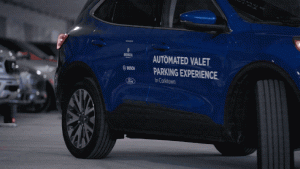Have you heard the good news? Self-driving cars will solve all our problems. If you believe the headlines, autonomous vehicles will reduce traffic congestion, improve commutes, save lives, and even solve “the loneliness epidemic.” Proponents of the technology often add another item to that list: these miracle automobiles will increase autonomy for older people. “Driverless cars could revolutionize old age,” The Telegraph declared a few years ago, by “liberat[ing] almost 1.5 million elderly people virtually trapped in their own homes because of poor or inaccessible public transport links.” A Digital Trends piece from 2017 expanded on this promise: “When automakers talk about autonomous cars as a boon to the elderly, they’re not only talking about today’s seniors,” the site explained. “They’re talking about you, sooner or later.”
This all could happen, eventually. Once driverless cars have reached their full potential—once they truly operate themselves—the benefits described above may indeed be realized. In the meantime, though, the opposite is true. Recent research suggests that driverless cars may do more harm than good for seniors in the phases leading up to completely autonomous vehicles. The fact that so many have suggested otherwise illustrates the ways technologists include older people in their work. Which is to say, they don’t include them at all.
The issues steering this conversation are real. As the number of older Americans grows, so does the number of older drivers on the roads. According to the Institute for Highway Safety, between 1997 and 2017, the number of licensed drivers over 70 increased 58 percent. These drivers over 70 have higher accident rates than younger drivers do.
Older drivers are well aware of this danger, and many of them self-limit their driving to protect themselves. This, in turn, can lead to isolation and loneliness—conditions with which many seniors already struggle. A 2011 study by Transportation America estimated that by 2015, 16 million people 65 and older would live in places without good access to public transportation. “People get scared to drive, often for good reason,” Matthew Lesh, the CEO of a company called Comet Mobility, told AARP recently. “And yet they still want their independence.”
Enter: self-driving cars. Instead of being forced to ask for a ride or hail a cab, seniors could one day find safety and freedom in one autonomous package. But that will happen only when the cars they have access to are completely and truly autonomous.
The dream of autonomous vehicles is that cars will really, truly drive themselves. Before we get there, we’ll first have to go through a few baby steps. Researchers divide these into levels, where Level Zero is a regular car and Level Five is a fully autonomous vehicle. Right now, experts generally agree that we’ve achieved Level Two, where cars have basic capabilities such as cruise control and can also complete more advanced tasks such as maintaining a constant distance from the car in front of them. At Level Two, humans still have to take control of their vehicles to make a turn or avoid an unexpected obstacle. That need for intervention is true of levels three and four as well, albeit to a decreasing degree.
What this means is that, until we reach Level Five, even so-called self-driving cars will require people to act and react in certain situations: when a child runs out into the street, for example, or the car approaches an unexpected pool of water. This is where the challenges for seniors become most clear.
Research finds that the types of accidents seniors are most likely to get into are ones caused by “inadequate surveillance.” In other words, they either didn’t look for hazards, or they did look but didn’t see them. It’s also true that drivers’ reaction times decrease as they get older. Which means that the situations where driverless cars need humans to intervene happen to be the very ones that older drivers struggle with the most. Last year, a study from Newcastle University found that drivers over the age of 60 took 8.3 seconds to take control back from the car when they needed to, while younger drivers took 7 seconds. “At 60mph that means our older drivers would have needed an extra 35m warning distance—that’s equivalent to the length of 10 cars,” said the study’s author, Shuo Li, in a press release.
It’s worth noting that even seven seconds, the time it takes a younger driver to take over the wheel, is a dangerous amount of time. To the extent pedestrians will be at risk from these mid-stage driverless cars, they’re more likely to be seniors, too. The US Department of Transportation estimates that people over the age of 65 are two to eight times more likely than other pedestrians to die when struck by a car.
Not only are the claims that these systems might help older people overblown, they’re also made, for the most part, without including those older people in studies of the effects of the technology. Li says that when the Newcastle team reviewed the literature to see what experiments had been done on aging drivers and driverless cars, they found almost nothing. “Older people, compared to younger people, have less access to this technology,” Li told me, referring not just to autonomous driving features on existing cars—Tesla Autopilot, Cadillac Super Cruise, and the like—but also to participation in the research on this topic.
This is a common cycle in technology, more broadly. Over and over again, designers claim their products will be great for an aging population without actually including that population in the conversation. “I think there’s been a lot of new technologies being marketed toward older adults but that haven’t necessarily been designed for them, with their capabilities in mind,” Wendy Rogers, a professor at the University of Illinois, told me for an episode of my podcast Flash Forward.
Take, for example, pill reminder devices—apps, or computer-enhanced pill dispensers that are meant to help seniors remember when to take which medications. These range from basic pill boxes with an alarm that goes off when it’s time to take them, all the way to internet-connected “smart dispensers” that look more like a SodaStream than a medicine cabinet. In many cases, such products were designed by younger people with little sense of what seniors actually need. “So, the buttons are small, the voice quality is not easy to hear, the number of steps required to set it up to get it to do what you want to do is complicated,” Rogers told me. “There are a lot of apps out there, things that are supposed to support pain management, for example, and they’re just not designed well for older adults.”
Instead of inviting older people to the design table or including them in studies and conversations about things like driverless cars, technologists make assumptions about what those people want and need. This year, Li and his team found that older drivers, for example, want more information about how a driverless car system works, even while they’re in it. The participants in the study said things like, “I need the car to tell me what it is doing if I am not watching it, just basic information would do, like speed, journey time;” and, “I want to know that the vehicle knows, and I would like some kind of display that let[s] me know the vehicle knows it is very foggy.” Collecting more feedback like this would lead to better designs for cars, pill boxes, and apps. It would also help technologists understand just how useful a new product category might really be.
For the time being, though, the driverless-car startups have pushed ahead on autopilot. Where they do draw on seniors’ help, the engagement isn’t always so direct: Some companies use retirement communities as testing grounds for their new technology. That’s not necessarily because older drivers will be best served by its current iteration but rather because those communities happen to provide walled-off and well-controlled environments for pilot projects. In a place like the Villages in Central Florida, where senior residents like to get around on golf carts, there are far fewer obstacles of the sort that would make it so a human driver has to seize control. That’s very helpful for the cars’ designers—it’s like training wheels for their technology. It’s too bad the local residents may not live long enough to see the wonders they’ve been promised.
More Great WIRED Stories
- The strange life and mysterious death of a virtuoso coder
- Alphabet’s dream of an “Everyday Robot” is just out of reach
- An origami artist shows how to fold ultra-realistic creatures
- Wish List 2019: 52 amazing gifts you’ll want to keep for yourself
- How to lock down your health and fitness data
- 👁 A safer way to protect your data; plus, the latest news on AI
- 🏃🏽♀️ Want the best tools to get healthy? Check out our Gear team’s picks for the best fitness trackers, running gear (including shoes and socks), and best headphones.



